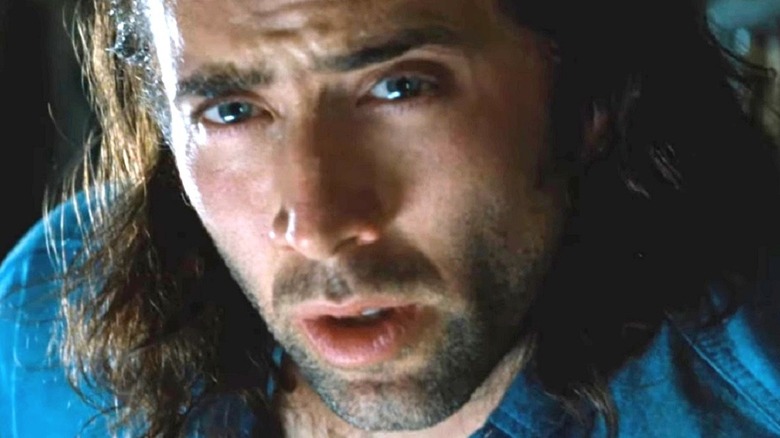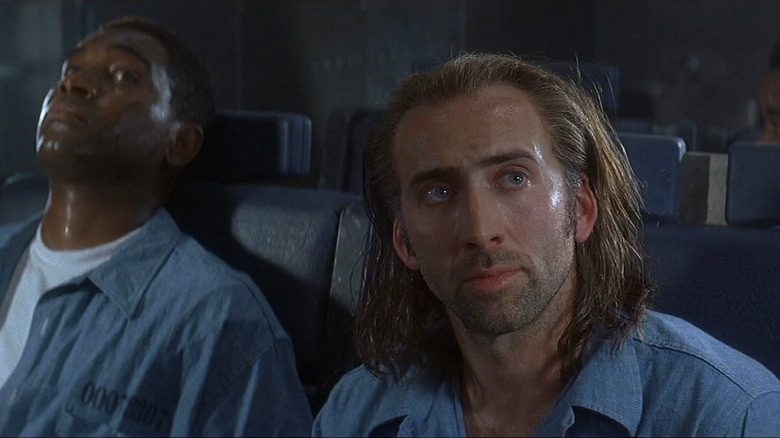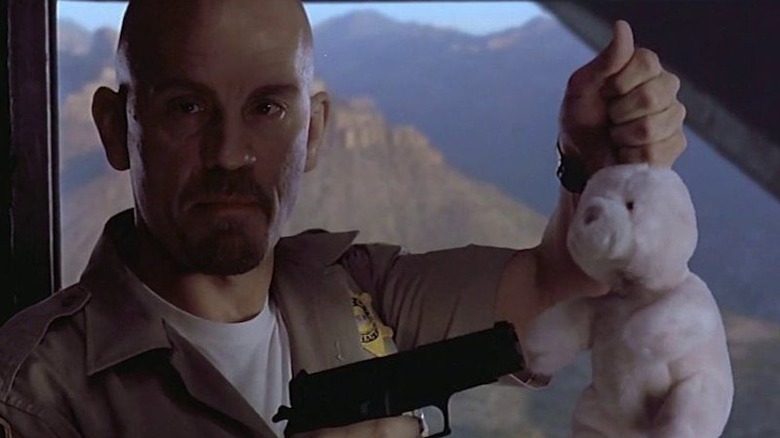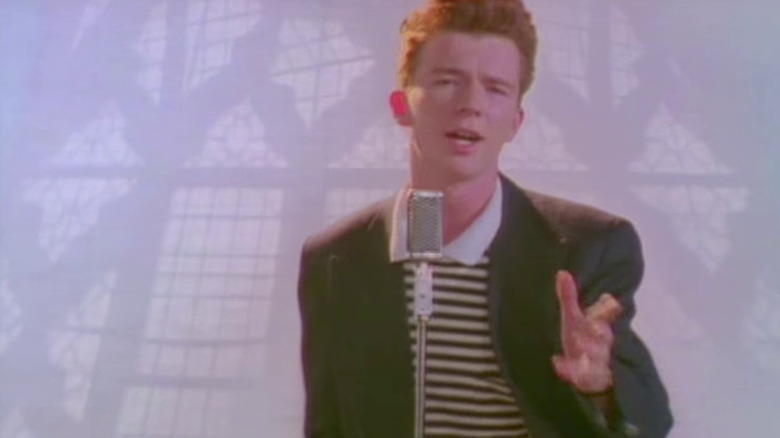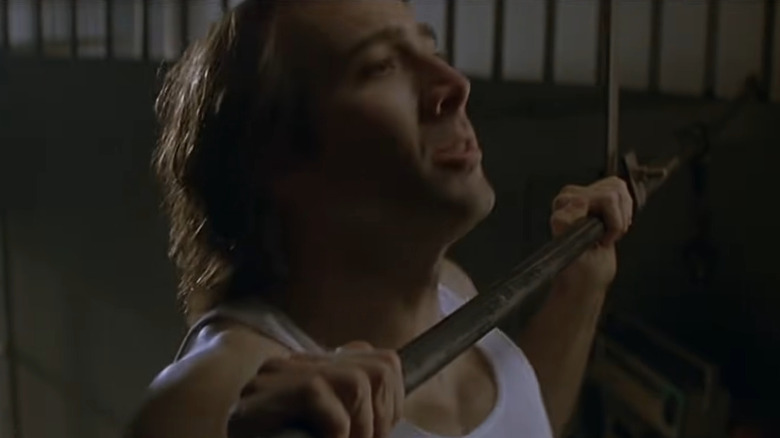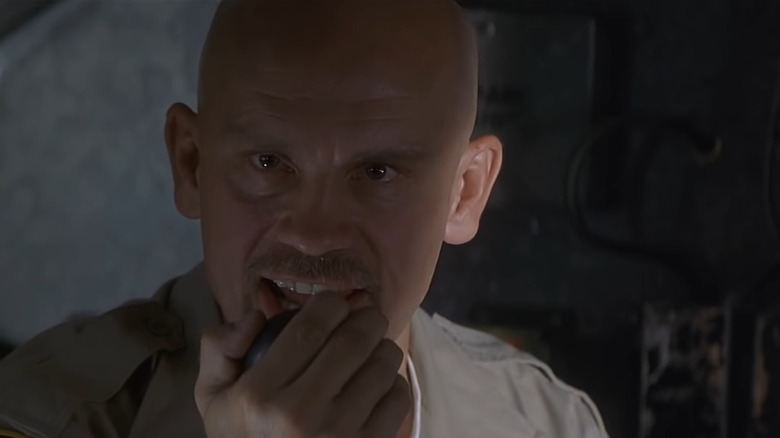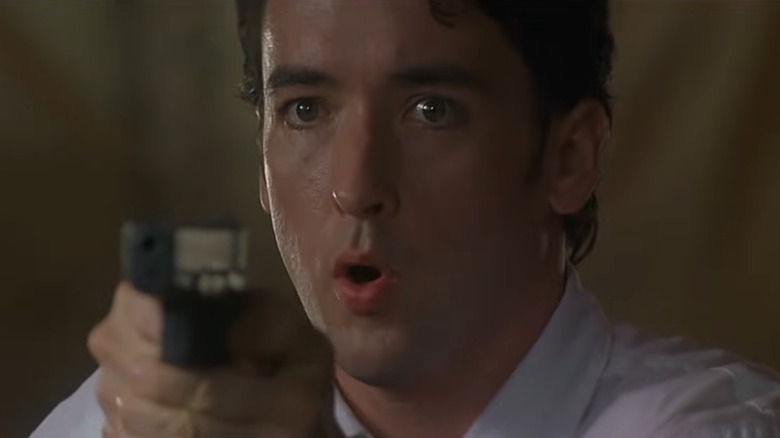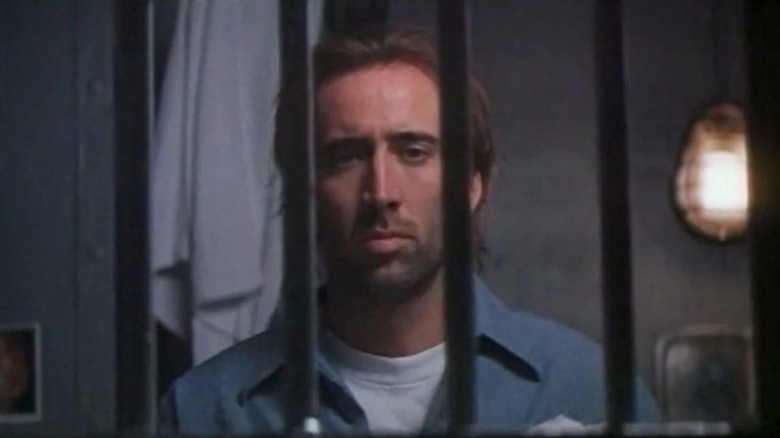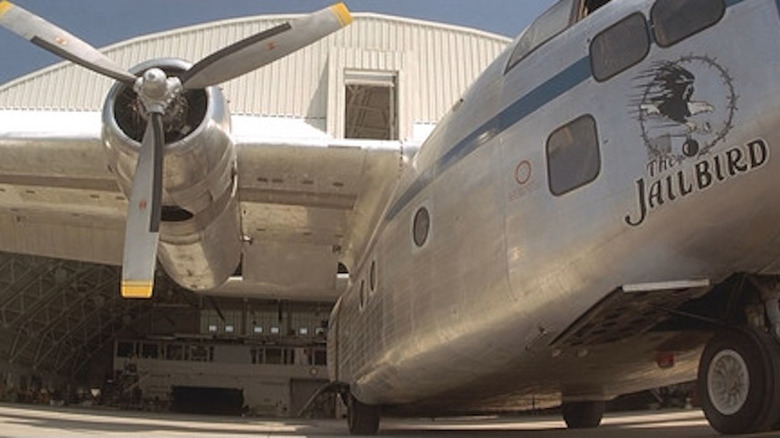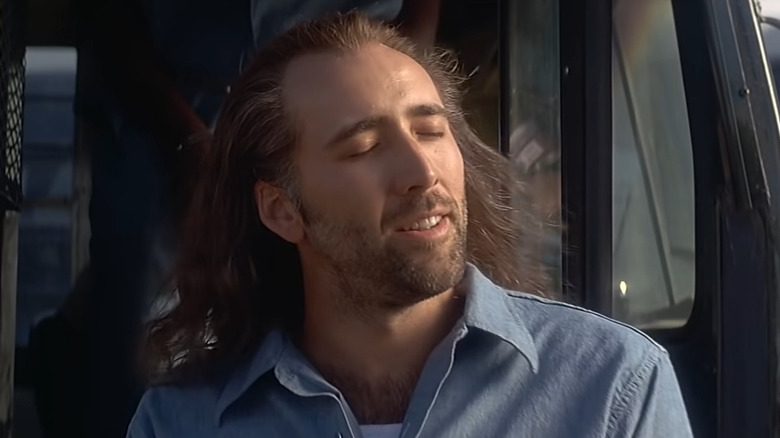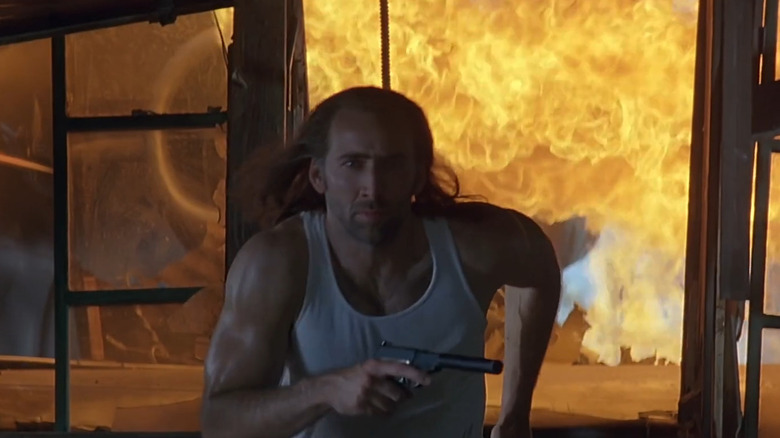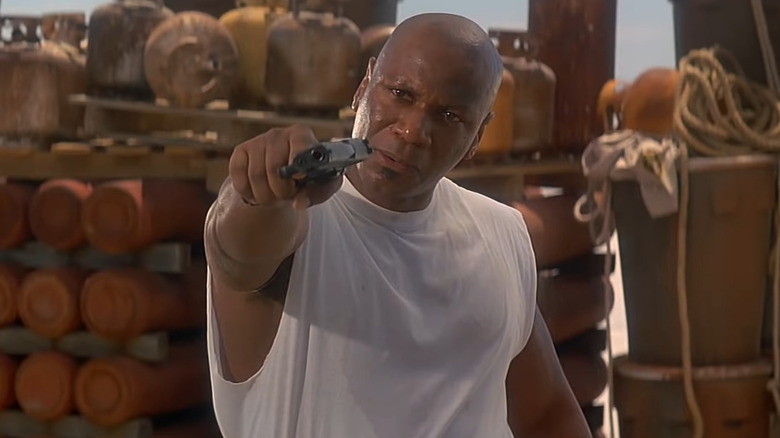The Untold Truth Of Con Air
"Con Air" may be one of the worst films in Nicolas Cage's repertoire, or it may be one of the best. That distinction is a matter of taste, but you can't argue with the fact that the film has become something of a cult classic since its release in 1997.
In the film, Cage plays Cameron Poe, a former Army Ranger who's sent to prison for killing a man attempting to assault his pregnant wife. Poe is paroled eight years later and on his way home to see his wife and daughter, only to be caught up in an inmate escape plan on a prisoner transport plane. In a desperate attempt to get out alive, Poe secretly works with U.S. Marshal Vince Larkin (John Cusack) in order to stop genius serial killer "The Virus" (John Malkovich) from completing his diabolical plan.
It's a totally outrageous film, but as with every movie in his filmography, Cage pulls it off by being utterly committed to the role. With his over-the-top Southern accent, his long, dirty hair, and his ripped physique, Cage did his best to make "Con Air" a character study wrapped inside of a Hollywood action spectacle. The supporting cast –- which includes the likes of Dave Chappelle, Steve Buscemi, and Danny Trejo –- adds a lot of color to the film, and even if you hate it, it's hard not to respect the big swings that were taken here.
With a movie as wacky as this, there's bound to be some good stories from behind the scenes, right? If you've been hankering to learn more about this harebrained movie, then you've come to the right place. Keep reading to discover everything you never knew about "Con Air."
How screenwriter Scott Rosenberg came up with the plot
Sometimes the inspiration for a film can come out of left field, but for "Con Air" screenwriter Scott Rosenberg, the story behind the film isn't all that dramatic. As Rosenberg explained to the Kid in the Front Row film blog, it was actually the folks at Disney who first had the idea. After the success of his 1995 film "Things To Do in Denver When You're Dead," Disney sent Rosenberg an L.A. Times article about the prisoner transport program that "Con Air" is based on.
"They wanted me to come up with an idea," Rosenberg said, "But they "didn't want 'Die Hard' on a plane."' He thought about it for a while, listened to a lot of classic rock, and then came up with the idea of a "guy who had never met his daughter" because he went to jail when his wife was pregnant. This totally unlocked the script for Rosenberg, who said he was then able to make it as bombastic as he liked because he had this central storyline. "Because, when all is said and done, he was just another man trying to find his way back home." And the rest is history.
The origin of the stuffed bunny
In between all of the fighting, plane crashes, and explosions, "Con Air" is filled with memorable quips and dramatic sequences that have stood the test of time — such as the scene with the stuffed bunny. Poe has brought a stuffed bunny with him on the flight, and he's determined to take it back to his daughter, no matter the cost. When one of the crooked guards on board discovers the bunny (and the fact that Poe is actually a free man), Poe confronts him, delivering one of the most iconic lines in cinema history. "Put the bunny back in the box" he demands, deadly serious.
It's a marvelous scene, and Cage was actually the one to come up with the idea of the stuffed bunny in the first place. Producer Jerry Bruckheimer told Empire that he gave Cage an early script for "Con Air" while he was still working on "The Rock," and they fleshed out the story together. Their main goal was to make Poe a more sympathetic character, so the first order of business was to make him an Army Ranger. It was Cage who had the idea to give Poe a stuffed bunny that was meant for his daughter, something that was to be "protected at all costs." Without Poe's stuffed bunny, what would "Con Air" even be? Just a bunch of guys fighting on a plane, probably, and not the cult classic it is today.
They crashed a plane through an actual hotel
One of the most impressive moments in the film comes near the end, when Nicolas Cage and the rest of the prisoners crash the plane into a hotel on the Las Vegas strip. You might think that a big-scale action sequence like that would be done on a set, but that couldn't be further from the truth.
In actuality, the hotel they crash the plane into was a real hotel in Las Vegas. The historic Sands Hotel and Casino was already set to be demolished, so the filmmakers were able to crash a real plane right into its front lobby. According to director Simon West, this scene was quite the feat to shoot. He told Metro that there were 200 stunt performers in that one scene and 17 cameras set up to get the shot because they could only do it once. The first day they tried it, the plane stalled, so they had to try again the next day. West estimates that there were around 10,000 or 15,000 watching the stunt, so the pressure was on.
While there were quite a few people in on the secret, not everyone in Vegas knew what was going on. In fact, the Las Vegas Sun reported that several residents called the police when they saw a plane flying in circles around the Las Vegas strip. For a short while, (prior to its demolition), the crash site was actually a tourist destination, producer Jerry Bruckheimer told Variety.
Director Simon West made a pretty famous music video before Con Air
"Con Air" may have been director Simon West's first feature film, but it wasn't his first directing gig. West got his start directing music videos, and one of them might just be one of the most (in)famous music videos of all time. West happens to be the director behind Rick Astley's "Never Gonna Give You Up" video, which started the "Rickrolling" prank.
West was surprised that the video became so big many years later because, as he told Metro, it was a "cheap, very quick" shoot. While the song was popular following its initial release, its popularity skyrocketed following the Rickrolling trend. As West put it, the song become "one of those things that haunts you."
Surprisingly, West hasn't actually been Rickrolled much himself. "People are sensitive to it, [but] people who know me really well know that I'm not gonna go ballistic," West said, noting that it's only ever happened to him "three or four" times. Nonetheless, West doesn't like it much at all, complaining, "When it happens, it's the worst thing!" Though he's now the director of action classics like "Con Air" and "Lara Croft: Tomb Raider," it seems that West may never escape his "Never Gonna Give You Up" legacy.
The opening sequence was inspired by Nicolas Cage's own workout routine
"Con Air" has a ton of memorable sequences, and one of them happens during the opening credits. After quickly going through the circumstances that lead to Poe's imprisonment, we get a montage of Poe in prison alongside a voiceover of the letters he's writing to his daughter. According to the montage, most of what Poe does while locked up revolves around reading, writing, and working out. Poe does pull-ups on the prison pipes and, most impressively, some pretty sick upside-down push-ups.
Director Simon West says this scene was directly inspired by Cage's own workouts in preparation for the film. West told Metro that Cage was the most focused, most prepared person on set and that some of his preparation involved physical fitness. "I would watch him practicing in the corner doing his fitness regime, and I would see him do something impressive, and I would put it in the movie." West said. "I looked over one day, and I saw him doing upside-down one-handed push-ups. So I put that in the title sequence." Time to add one-armed push-ups to Cage's already impressive resume.
The other actors who auditioned for The Virus
Director Simon West told Metro that John Malkovich was always the first choice to play Cyrus "The Virus" Grissom, but there were other actors in the running, including Jason Isaacs. West's reasoning for not casting Isaacs was that he was just too good-looking, explaining, "He was very handsome, and he still is, and he was never gonna be the bad guy — no one would be scared of Jason Isaacs with his blue eyes and square jawline!"
We might have to disagree with West here since Isaacs did convincingly play the conniving Lucius Malfoy in the "Harry Potter" series, but we're not going to argue with Malkovich's casting. In an interview with Collider, Isaacs said that auditioning for the role was actually pretty terrifying. He read a scene where the character was meant to be holding a gun, so Isaacs picked up a pencil as a prop. The camera operator told him to wait and instead put an actual gun in his hand, reassuring Isaacs that the safety was on. Isaacs was understandably freaked out by the incident, as was West, who didn't know one of his crew carried a gun.
West told Empire that Mickey Rourke also read for the part, and his audition was also somewhat harrowing. As West tells it, Rourke was reading a confrontational scene with an assistant casting director reading the part of Poe when the actor pulled out a huge knife and held it to the poor assistant's neck. West says they let the scene keep going, but suffice it to say, Rourke was not cast in the role. (Luckily, no one was harmed in the process.)
John Cusack decided his character should wear sandals
John Cusack, who doesn't seem to like "Con Air" that much and has said he mainly took the job to get his name on billboards, did have some input on his character. Cusack plays Vince Larkin, a U.S. marshal secretly working with Poe to stop the escape plan. There's one small character detail about Larkin that makes a world of difference, and it was all Cusack's idea. Though Larkin is a federal agent who wears a suit and tie, he also has an odd choice in footwear: sandals.
Cusack explained this choice in a video for GQ. "Charlton Heston did a lot of stuff with no shirt and sandals, but I've never seen a modern movie with an action star wearing sandals." For Cusack, that was all he needed to get into the headspace of the character and, really, all he felt the need to contribute to the film as a whole. "So I wore Birkenstocks, and that was sort of the extent of my thinking on that one. Once I had the sandals, I think everything came from there," he added.
Nicolas Cage visited Folsom Prison in preparation for the role
As director Simon West has said, Nicolas Cage is all about preparation. In order to prepare for the role of Cameron Poe, one of the things Cage did was visit Folsom Prison and talk with the inmates. In an interview for the film, Cage called it an "intense" experience. He said it was difficult doing interviews with the incarcerated men because, "Whereas they were very polite, they were, you could trip out on what it was exactly they had done." Meanwhile, he said that the men he spoke to all wanted tips for how to break into the acting business.
Cage wasn't alone when he visited the prison, as he was accompanied by director Simon West, producer Jerry Bruckheimer, and screenwriter Simon Rosenberg. Rosenberg told Empire that the experience was slightly frightening as crowds started to envelop them when people began recognizing Cage. Suddenly, as things began to get a little intense, there was a stabbing across the yard. Guards grabbed the group and quickly got them out, but Bruckheimer hasn't forgotten what it felt like. "I say this now," Bruckheimer said, "I felt okay — but that's 'cause I'm out of there. I was nervous."
Someone died while working on the film
While filmmaking may seem like a fun profession, film sets can be notoriously dangerous places –- just ask Francis Ford Coppola and the cast and crew of "Apocalypse Now." Action films tend to be the most dangerous of them all, especially where stunts and machinery are involved.
Unfortunately, "Con Air" is an example of the dark side of film production. The big set of "Con Air" is the Jailbird airplane that the prisoners are transported on. The model they used was called the C-123, and tragically, a welder named Phillip Swartz died while working on the plane in Utah. Swartz was working for a special effects company based out of Los Angeles at the time and was survived by a wife and four daughters. "Con Air" is dedicated to Swartz in the movie's credits.
Oddly enough, Swartz's death wasn't the only terrible accident involving the Jailbird. The C-123 used in the film was sold some years later, and it crashed in Denali National Park in 2010, killing three men. It's certainly a tragic ending for "Con Air's" most famous artifact.
There was a lot of competition and macho energy on set
"Con Air" is a movie filled with burly men and very few women in sight, so it's not surprising that the set would've been a pretty macho environment. But don't take our word for it, take it straight from Danny Trejo. Trejo played Johnny 23 in the film, and he's famously an ex-con himself. In an interview with Den of Geek, Trejo described the film as "the biggest test of testosterone I've ever had." He went on to say how competitive things got on set, saying, "If you spit, somebody would try to spit further and then further and further and pretty soon you'd have a spit war going on -– everything was a contest on that movie!"
They shot much of the film on the Utah/Nevada border, where the temperature reached 120 degrees. "You can imagine, it got pretty macho out there in the desert," Simon West told Empire. He recalled that everyone was shirtless on set because it was so hot, and everyone was competing to see who could do more push-ups and pull-ups. The cast and crew would all wrestle each other during lunch, and West says, "It did become a bit like a prison." Cage, who was extremely focused on his role and all the preparation he had done, didn't participate in all of the off-screen shenanigans, said writer Simon Rosenberg.
Cage did most of his own stunts
If you've done any research into the great Nicolas Cage, you've probably learned that he's not one to do things halfway. That was certainly the case for "Con Air," a project that he took extremely seriously despite its rather outlandish premise. Though there were numerous stuntmen involved in the film, Cage has said that he did many of his own stunts.
In a TV special about the making of the film, Cage explained, "Whether I wanted to or not, I did most of my own stunts in this movie. There were explosions five feet behind me, flaming helicopters dropping right behind me, ball-bearing bullets over my head." This all sounds quite harrowing, but for Cage, it may have actually helped his performance. "There was a level of intensity, fear, you might say," he added. If there's one thing that makes a Nicolas Cage movie so compelling to watch it's this exact intensity, so we're glad he was able to bring 100% to the film (all while remaining in one piece.)
Many of the characters were based on rock songs
All of the characters in "Con Air" have distinct personalities, and they also have some pretty unique names. As it turns out, most of the characters in the film were inspired by music, as screenwriter Simon Rosenberg was listening to a lot of Lynyrd Skynyrd and the Allman Brothers Band while he was working on the script, reports Empire.
Poe was inspired by Southern rockers like Ronnie Van Zant and Gregg Allman, who both sported long hair. Diamond Dog, who was played by Ving Rhames, got his name from the David Bowie song, and Jonny 23 (Danny Trejo's character) was inspired by the Bruce Springsteen song "Johnny 99." Meanwhile, Sally Can't Dance (Renoly Santiago) is the title of a Lou Reed album. The film itself doesn't feature a ton of classic rock, but Lynyrd Skynyrd's "Sweet Home Alabama" does play during the credits at the end of the film.
